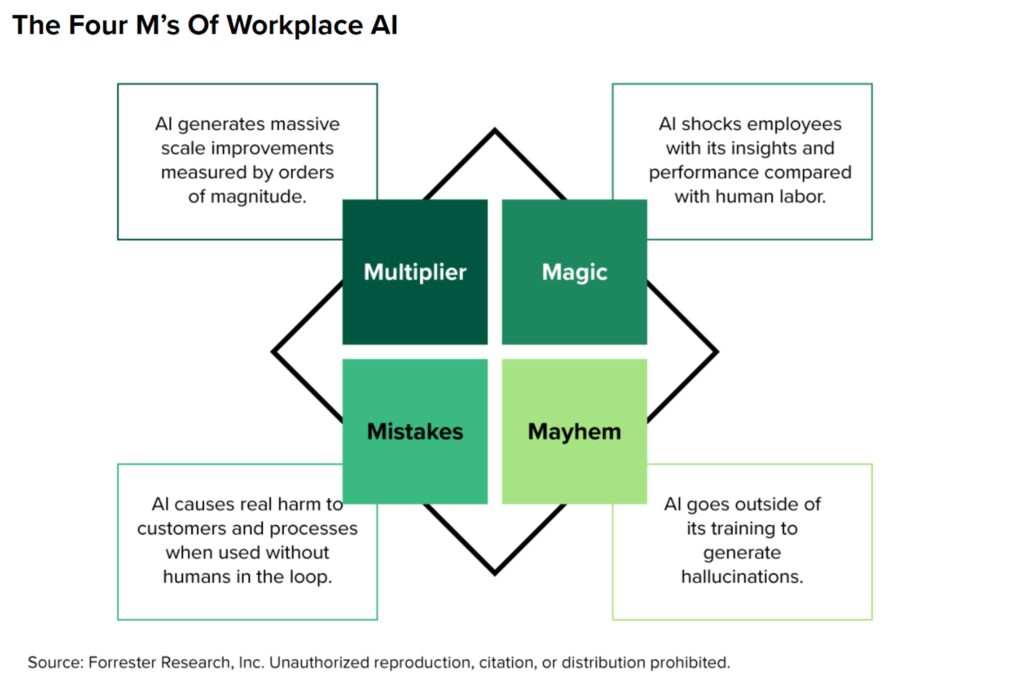The Four M’s Of Strategic Workplace AI
Generative AI has catapulted the topic of artificial intelligence to the forefront of workforce strategy. But leaders who we talk to, while excited by the technology’s potential, are worried. They fear the fast pace of change and wonder if their employees will be able to adapt. As a result, even as ChatGPT reached a billion page views in less than four months, negative responses came nearly as quickly, as companies such as Apple and Deutsche Bank banned ChatGPT from their corporate networks. Yet bring-your-own (BYO) AI is inevitable, and banning ChatGPT doesn’t solve the problem. Instead, you urgently need to develop a workplace AI strategy.
The Four M’s — Multiplier, Magic, Mistakes, And Mayhem — Help Frame Your Workplace AI Strategy
If you aren’t already, you’ll soon be embedding AI in nearly all your enterprise workflows. But doing so isn’t risk-free. To balance the disruptive potential of AI with the risks involved in deploying it requires a framework. Enter the four M’s, which we developed to help you think through how AI impacts the workforce. In our new report, we lay out the details of how the four M’s will empower — and challenge — every organization:
A classic case of “changing the engine on the airplane while it’s in flight,” AI forces you to contend with each of the four M’s along the way:
- Multiplier: AI drives massive scale. AI acts as a force multiplier, driving results at scale and reshaping what’s possible. Creating personalized communications for customers at scale becomes feasible using large language models (LLMs) and generative pretrained transformers (GPTs), changing how marketers develop their campaigns. There are similar opportunities lying in wait across your business, problems to which you can apply the multiplier effect of AI to solve.
- Magic: AI shocks humans with its performance. In recent research interviews, we’ve found that experts refer to “November 30, 2022” with reverence — that is, the date that ChatGPT became generally available. Millions of everyday users have experienced its seemingly magical ability to answer questions. So savvy are generative AI LLMs that they can hold multiturn conversations (keeping the context of the topic in mind); these capabilities open up the possibility of individual GPT tutors that can personalize learning in real time based on the conversation that they have with one of your employees. This magic aids workforce adoption: Employees are eager to try it out.
- Mistakes: AI causes real harm if used in isolation. Enterprise leaders who we talk to are keeping in mind AI’s potential to make mistakes — some of which are deeply troubling. Absent human intervention, AI can make harmful decisions, like granting a husband a 20 times higher credit limit than his wife … even though she had a higher credit score and income, apparently due to algorithmic gender discrimination. Think about how your customers might react to similar errors.
- Mayhem: AI risks chaos with its hallucinations. My colleague Rowan Curran, who leads our generative AI research, warns about the technology’s proclivity to generate “coherent nonsense.” It can “hallucinate,” spitting out content that is nonsensical or unfaithful to its training data. The resulting mayhem will make your risk managers’ hair stand on end.
Accelerate Your Workforce AI Strategy By Assessing Your Readiness
Successfully applying the four M’s requires a human-centered strategy. Yes, your AI workforce strategy requires lots of human participation! That’s because every AI deployment sits atop human foundations, without which you can’t appropriately harness its power. These human foundations include a series of skills, inclinations, beliefs, norms, and structures. To accelerate your AI future of work strategy, you must understand where you stand today. How ready are you, and what areas should you invest in to prepare?
For the past five years, we’ve used a model we call RQ, the robotics quotient, to help leaders accelerate their AI strategies. RQ measures the ability of individuals and organizations to adapt to, collaborate with, trust, and generate business results from AI and automation. All things being equal, organizations with higher RQ will gain more value and success than those with lower RQ. Our new report helps you get started.
We Invite Clients To Read Our Two New Reports
- The Artificial Intelligence Pathway To The Future Of Work, a vision report that introduces the four M’s and argues that you must keep humans in the loop as you deploy AI into your operations.
- How To Accelerate AI In Your Future Of Work Strategy, a decision tool that helps you benchmark the readiness of your employees, leaders, and organization to drive success with AI. Clients can schedule a guidance session or inquiry with me to personally guide your use of this decision tool and to determine your next steps.
J. P. Gownder is a vice president and principal analyst on Forrester’s Future of Work team.

